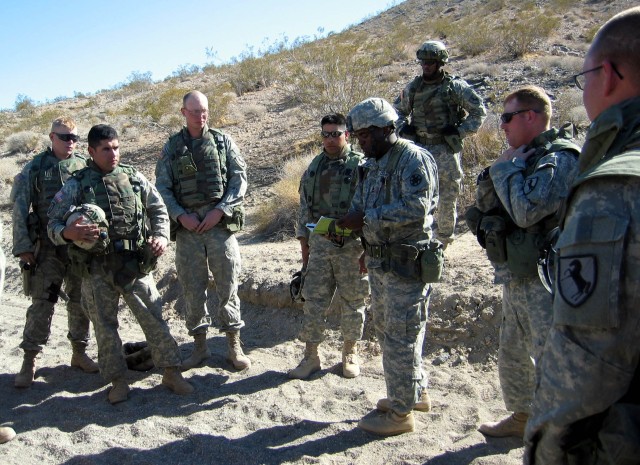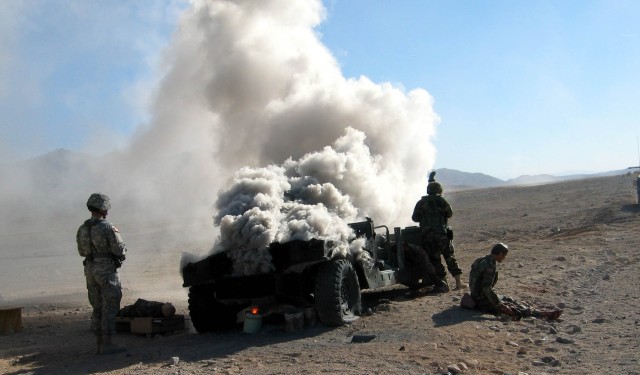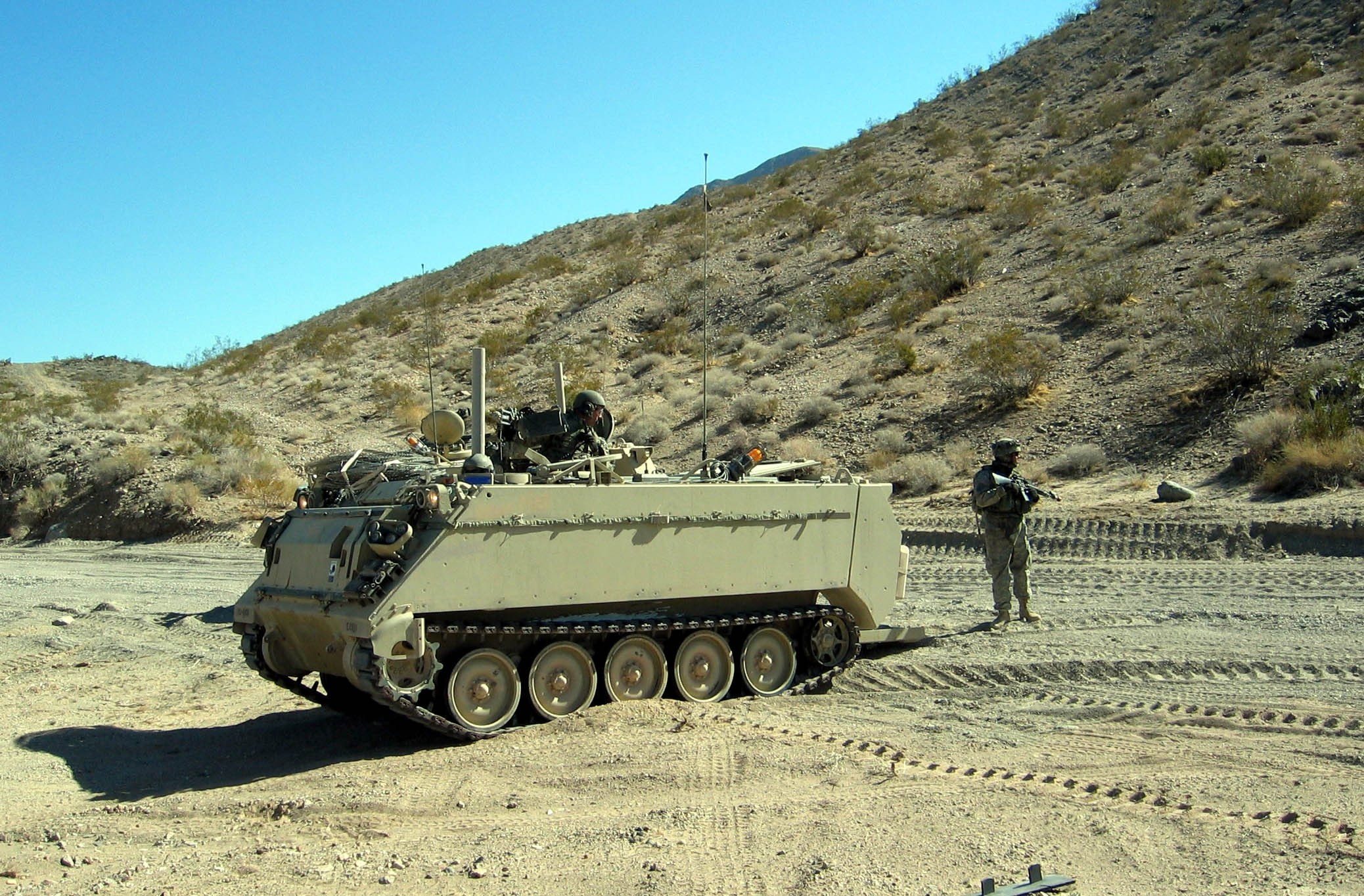FORT IRWIN, Calif. (Army News Service, Jan. 30, 2007) - As a full-time member of the opposing force at the National Training Center here, Spc. Tim Lawson is accustomed to putting troops preparing to deploy through rigors like they'll confront in Iraq and Afghanistan.
But now that Lawson and his fellow 1st Platoon, 58th Combat Engineer Company, troops have orders to Iraq, they're getting put through the same paces themselves. And with the shoe on the other foot, they're realizing just how difficult the challenges - especially those posed by IEDs - are.
Not long into a route-clearing training mission with his mock Buffalo mine clearing vehicle, Lawson got a taste of what it's like to come up against what's become the No. 1 killer of U.S. troops in Iraq.
"Once you get into the zone, everything looks suspicious," Lawson said after his "Buffalo" - actually a heavily modified 5-ton truck - and four other vehicles got "ambushed" by "snipers" and two vehicles got hit with simulated IEDs.
The training, offered by NTC's Operations Group in cooperation with the new Joint IED Center of Excellence, is helping arm Lawson's unit with the most up-to-date ways to confront roadside bombs, vehicle bombs and even terrorists laden with suicide vests.
The Joint IED Center of Excellence opened its doors here in summer 2006 to share the latest counter-IED tactics, techniques and procedures with deploying troops, explained Air Force Lt. Col. Rodney Taylor, the center's chief of integration.
By quickly incorporating lessons learned on the battlefield into training scenarios - sometimes within 24 hours after an event - and exposing troops to the IED-defeating technology they'll use in the theater, it's giving them a critical leg up on their adversaries, he said.
"The enemy is continuing to evolve in its approach and its tactics, so we have to stay ahead of the game," Taylor said. "We have to be proactive."
The Joint IED Center of Excellence is part of the Joint IED Defeat Organization, a Washington-based group focused specifically on the IED threat. The center works hand in hand with four service IED centers of excellence to ensure the most comprehensive approach to countering IEDs, explained Christine DeVries, spokeswoman for the Joint IED Defeat Organization. The Army's center is here at Fort Irwin; the Marine Corps' at its Air Ground Combat Center in Twentynine Palms, Calif.; the Air Force's is at Lackland Air Force Base, Texas; and the Navy's at Indianhead Naval Base, Md.
The Joint Center of Excellence builds on training the services are conducting, she said, gathering lessons learned throughout the military and ensuring they're shared with the widest possible audience.
It also recognizes that every service has a stake in the IED fight and a variety of skills sets to lend, Taylor said. The Army, for example, contributes combat arms and military intelligence troops. The Marines provide reconnaissance specialists and communications capabilities. The Air Force provides electronic warfare officers and military working dog specialists. The Navy contributes explosive ordnance disposal specialists and cryptologists.
"There are a lot of specialties, and although it may not be intuitive, they all bring something to the table in terms of the IED threat," Taylor said.
The Joint Center of Excellence focuses on helping prepare deploying troops for their own role in the IED fight, but also ensures they know what capabilities the other services can contribute.
"What people get here is an understanding of the large number of assets that can be brought to bear in the IED problem," Taylor said. "When they come here to a joint environment, they learn a lot (about those capabilities). And that's important, because when they show up in Iraq or Afghanistan, they are going to be in a joint environment there."
Here at the home of the Army's Center of Excellence, the training scenarios are designed to give troops a basic foundation in the most up-to-date counter-IED tactics and exposure to some of the specialized equipment they wouldn't otherwise see until they arrived in the combat theater.
"When they leave here, they will be trained to where they understand what it is to operate in an IED response sequence," said Capt. Sean Patrick, an observer-controller here.
That means incorporating what Patrick called the "five Cs" of IED response: "call" or identify a potential IED, "confirm" that it's an IED, then "cordon," "clear" and "control" the area.
Detecting IEDs can be particularly difficult because they can be hidden almost anywhere, and every pile of rubble or garbage is suspect, he explained, so the training focuses on situational awareness.
"We're training Soldiers to be keen, to be acute and to be paying attention," Patrick said. "Our goal is to impart our experience so when it comes down to them being able to execute, it's second nature."
Sgt. Edgar Huezo, a member of the 58th Combat Engineer Co., welcomed the training he's receiving as the clock ticks toward his unit's deployment. "Going through this training basically prepares the mind to be confident in what you are doing over there," he said. "And if you make a mistake, this is the place to do it, because you can improve it before you go."
Sgt. Marcus Williams, a member of the 3rd Infantry Division's 1st Battalion, 15th Infantry Regiment, is preparing for his third deployment to Iraq and understands firsthand the damage IEDs can do.
But despite a lot of experience under his belt and limited time stateside before his unit deploys, Williams said he recognizes the value of the training the troops are getting here.
"This is getting us prepared for what we are going to face over there in Iraq," he said. "This is the place where the new guys are getting a chance to work out the kinks, and the veterans are getting to work out their (standard operating procedures). So it's very worthwhile for us."
Encountering a real-life IED forces everyone involved to focus on the situation and respond quickly, Williams said. "That's when you have to snap out of a panic mode and react," he said. "And that's when you fall back on your training."
In addition to providing troops the specialized training they need to identify and clear IEDs before they explode, the Joint Center of Excellence serves as a focal point for developing and testing new technologies to defeat them and better ways to foil the networks responsible for emplacing them, DeVries said.
Toward that end, the scenarios are focused not just at the individual and small-unit level, but also at the battalion and brigade level. As ground troops scan their patrol routes for hidden IEDs and equipment operators get experience in detonating the devices with equipment like they'll use in the theater, headquarters staffs focus on intelligence operations designed to track down the terrorists who emplaced IEDs.
"We want to find and defeat the devices before they hurt people, and when we find an IED, we want to explore the forensics of it," DeVries said. "But you can't stop at defeating the devices. You have to attack the network and take out the guys who are using them."
The tactics used to conduct these far-ranging operations require flexibility and adaptability, Taylor said.
"The enemy we face today appears to be a decentralized type of enemy, a headless enemy. If you cut off a portion of it, it still is able to operate," he said. "So we have to think outside the box in our approach, to be sure we are on the leading edge of technology and capability so we can effectively defeat the enemy."
Ultimately, countering IEDs has huge implications for U.S. military operations in the war on terror, Taylor said. Although IEDs may be relatively simple weapons, he said, they have the impact of strategic weapons. "If IEDs kill enough Americans, that may change the will of the American public, which is what we require in order to stay in Iraq and get the job done," he said.
As American troops focus on getting the job done, Patrick said, the training being offered here is going a long way toward preparing them to face IEDs. "Every minute we spend training these guys can effectively help ensure we're able to bring them home," he said.






Social Sharing